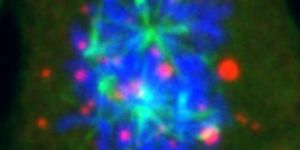The CRISPR/Cas9 gene-editing system took the research world by storm when it was first introduced. With just a few simple reagents inspired by an immune defense system in bacteria, researchers learned how to make edits to the genome, in a method that seemed straight-forward and ripe with possibilities. While some of them are being realized, new research is tempering our expectations. Some work has shown that the CRISPR editor might increase the risk of cancer. Another new study has found that the process makes more extensive changes than we knew, causing serious damage to the genome of cells growing in culture.
Scientists at the Wellcome Sanger Institute have found that the typical techniques that check for genomic damage can miss what they are seeing - big deletions and insertions after CRISPR is used. Reporting in Nature Biotechnology, they urge caution especially when using CRISPR for human gene therapies.
"This is the first systematic assessment of unexpected events resulting from CRISPR/Cas9 editing in therapeutically relevant cells, and we found that changes in the DNA have been seriously underestimated before now. It is important that anyone thinking of using this technology for gene therapy proceeds with caution, and looks very carefully to check for possible harmful effects,” said the corresponding study author, Professor Allan Bradley of the Wellcome Sanger Institute.
In this work, the researchers looked for unintended mutations, also called off-target effects, of the CRISPR/Cas9 tool. Not many have been observed near the region targeted for changes, so the investigators looked further afield. In both human and mouse cells, they found frequent and extensive mutations far from the intended edit site.
Many of those mutations were found to be big rearrangements, in which large chunks of DNA are inserted or removed from the genome. That could have many potential negative effects on gene expression.
Related: Concerns About the CRISPR/Cas9 Gene Editor
"My initial experiment used CRISPR/Cas9 as a tool to study gene activity, however, it became clear that something unexpected was happening,” explained first author Michael Kosicki of the Wellcome Sanger Institute. “Once we realized the extent of the genetic rearrangements we studied it systematically, looking at different genes and different therapeutically relevant cell lines, and showed that the CRISPR/Cas9 effects held true."
Certainly, this and other related findings will force a reassessment of the CRISPR technology and will probably lead scientists to continue to look for reliable ways to manipulate the genome.
"This study is the first to assess the repertoire of genomic damage arising at a CRISPR/Cas9 cleavage site. While it is not known if genomic sites in other cell lines will be affected in the same way, this study shows that further research and specific testing is needed before CRISPR/Cas9 is used clinically,” concluded Professor Maria Jasin of Memorial Slone Kettering Cancer Centre, New York, who was not a part of this work.
Sources: AAAS/Eurekalert! Via Wellcome Trust Sanger Institute, Nature Biotechnology








